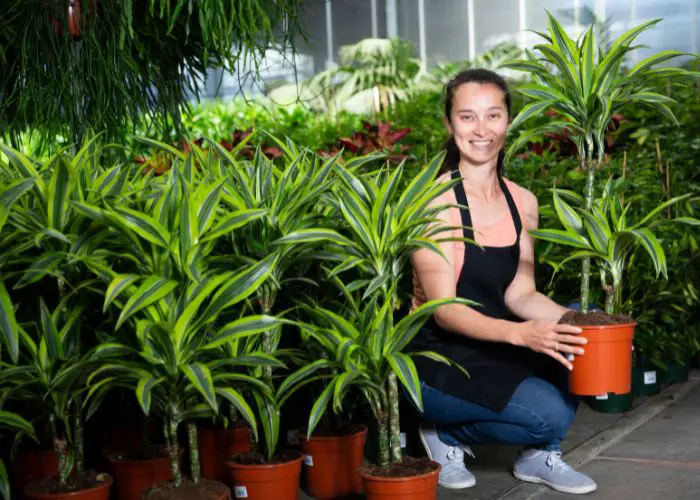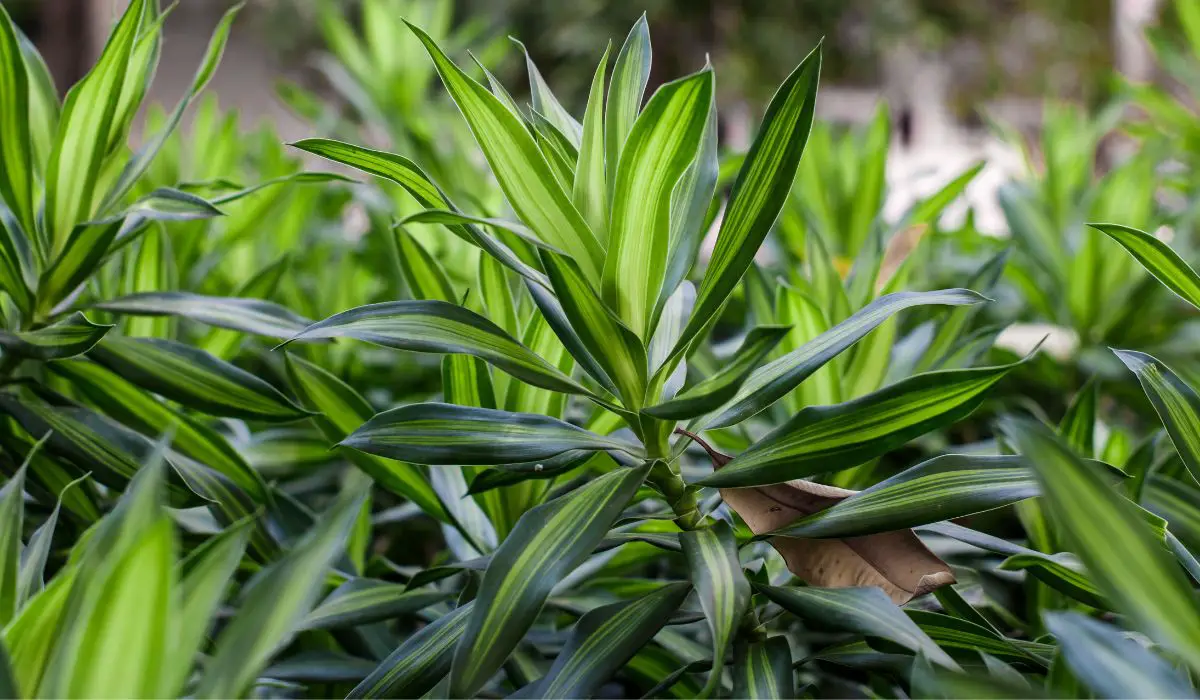Last Updated on September 3, 2022 by Griselda M.
Every day I walk my dogs through a piece of indigenous forest near my house and enjoy the wild Dracaena plants. The ecosystem in which these plants grow is very ancient and very rich in biodiversity. By observing what grows well in nature with the plants, we can then extrapolate this to what you can grow in your garden or pots.
I do this, and have a lot of Dracaena plants dotted around the garden and even in my bathroom. Read this article for my views on how to grow Dracaena, and what Dracaena companion plants are suitable.
What is a Dracaena Plant?
Dracaena is a genus of flowering plants that includes about 120 species. Plants such as the snake plants (Previously genus Sansevieria) have been included in this genus now. What this means is that the genus contains some of our most beloved house plants and easy-to-grow garden plants.
These plants tend to be quite a drought tolerant in general, have strong root systems that can store water, and have beautiful waxy leaves. In general, most of the commonly cultivated indoor varieties are selected based on their ability to tolerate low light conditions. I have been growing these plants for decades both indoors and outdoors and find that they are almost impossible to kill. Let’s have a look at what you can do to make your Dracaenas even happier by allowing them to have companions to grow with as they do in nature.
What Do You Need To Know Before Growing Your Dracaena?
The majority of the plants that we commonly grow indoors, that are Dracaena genus, require light, well-drained soil. Generally, if you can get soil that has an abundance of compost, a bit of pearlite, and a loam to sandy structure, you will find your plants will thrive.
Generally, the majority of Dracaena plants can tolerate relatively low light conditions – but they do need a long enough photoperiod that they can get some photosynthesizing done. To elaborate – a plant uses the sun to make sugar by day, and at night it consumes this sugar. If the plant uses too much sugar at night (the night is long) and does not produce enough during the day (the day is short) the leaf Brix, or concentration of sugars and salts in the leaves, will drop.
As this happens, the plant will either die, or start to get diseases and look pathetic. Hence giving your plant at least 10 hours of light, will help to ensure it is healthy. If you live in an area where plants would get less than this in winter, you will need supplemental lighting.
The majority of the Dracaenas that we plant indoors, or in our gardens tend to be plants that like to be watered, and then the soil should dry out before the next watering cycle. This allows the plant to have healthy roots. If you overwater them, they can develop root rot, which is not a good thing. I have also found with some of these plants that if you overwater them they develop these crazy water-storing roots that break the pot!!
What is Companion Planting?
Companion planting refers to planting two or more complementary plants together. This allows each plant to be healthier than if it were on its own. When we companion plants, we choose plants that will benefit each other, rather than compete with each other.
A good example of companion planting is when we grow avocados. These plants are very sensitive to heat, light, and various stresses when they are small plants. If we companion plant them with a fast-growing plant that can provide shade and shelter, the young avocado can grow up and thrive.
I have had some luck using amaranth as a companion plant for avocados – the amaranth provides shade, and also helps to keep the soil dry – avocados do not enjoy too much water on their roots when they are young. Having companion plants to provide shade for the avo ensures far greater success rates in getting your trees established.
Dracaenas are typically forest floor plants. In my experience, the plants I have seen them growing with tend to be ground covers, under trees, or with ferns and Streptocarpus. I have also seen them growing with ground orchids of various types and spider plants (Chlorophytum chromosome).

How To Start Companion Planting?
This will probably initially be determined by which Dracaena you are growing. Here would be a few tips I would give on plants that pair well and look nice:
Lucky bamboo
Dracaena sanderiana – this plant is actually not bamboo! Lots of people buy this thing in a weird pot of water, and after a while plant it over to soil. When you do this, it will grow upwards and form a small shrub-like houseplant a few feet tall. You can easily plant small ferns under this, spider plants, or even other Dracaenas, such as the Dracaena trifasciata (snake plant).
Snake plant
Dracaena trifsaciata (and similar species of which there are many). This plant can be grown with other plants – as discussed above. It does sort of taking over with time, so you will have to manage the relationship. If have seen this plant form a nice understory to a big Jade Plant – Crassula ovata. In the wild, Crassula ovata often grows naturally with very similar indigenous Dracaena species.
Large Leafed Dragon tree
Dracaena aletriformis. This is my favorite of all the Dracaenas I grow. When this plant is small it makes a cute understory plant in mixed pot and garden plantings. With time it will eventually grow up and become a dominant little plant up to about 6 feet tall. If you are lucky. This will take half a lifetime. You can plant many plants below this plant as well – I love it with Calla/Arum lilies. It grows well with certain smaller ferns, and of course spider plants.
How To Find Out What Plant Pairings Are Suitable For Dracaena Plant?
The above list shows a few options. You can definitely try and pair it with a lot of other plants, and generally, because Dracaena plants are quite cooperative, you can mix them with many other plants – lilies, flowers, and various other plants.
My general observation is that these plants seem to be able to form a relationship with pretty much any other plant that is not very dominant. Peace lilies, bromeliads, orchids, aloes, succulents, ferns – the list goes on.
Conclusion On Dracaena Companion Plants
Dracaena is a pretty diverse group of plants. Some grow up – some grow along the ground. Some just sit in one place and do very little.
Generally, they can cooperate with other plants quite easily, and I have had a lot of success over the years using smaller Dracaena plants as an understory below bigger plants, in some cases other Dracaena plants that grow large. These plants can transplant relatively easily in most cases, so if you have to move your plants around every few years to keep things pretty they are quite tolerant of this.
FAQ
Can I plant dracaena with other plants?
Yes, they generally grow well with many other plants.
What houseplants can be potted together?
If you pair plants that do not compete, they can be planted together. Hence if you have a plant that grows up, and another that covers the lower layer of soil, then you have a sustainable system.
Why is it important to have different plants in a garden?
It will depend on you. I once knew a guy who only liked lawn, and he had one type of grass. That worked for him. For me, I like to live in an ecosystem, so to create an ecosystem, we populate ecological niches - different plants can occupy different niches. Hence the more species you have, the more resilience your garden ecosystem has.
How much space should be between plants?
There is no hard an fast rule here at all. Some plants can grow right next to each other, others need to be feet apart! You will have to learn a bit more about plants to get a feel for this! If you plant plants that grow up, and then others that grow across the ground below these plants, you can plant them right on top of each other!
Read more about Do Spider Plants Attract Spiders? – Find The Best Answers Here
Branko is the world‘s most enthusiastic gardener! He is always on the hunt for the perfect flower, bush or tree to add to his ever–growing garden. He is known for his love of all things green, and his passion for nurturing the plants he grows is unmatched. He loves to get his hands dirty and can often be found humbly tending to his garden at all hours of the day. Branko is the go–to guy when it comes to gardening advice – he is always happy to share his knowledge and wisdom with anyone who will listen. He also loves to play pranks on unsuspecting visitors, so beware if you enter his garden!



